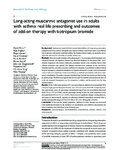Long-acting muscarinic antagonist use in adults with asthma: real-life prescribing and outcomes of add-on therapy with tiotropium bromide
| dc.contributor.author | King, C | |
| dc.contributor.author | Price, D | |
| dc.contributor.author | Kaplan, A | |
| dc.contributor.author | Jones, Rupert | |
| dc.contributor.author | Freeman, D | |
| dc.contributor.author | Burden, A | |
| dc.contributor.author | Gould, S | |
| dc.contributor.author | Ali, M | |
| dc.contributor.author | Thomas, M | |
| dc.contributor.author | von Ziegenweidt, J | |
| dc.date.accessioned | 2016-01-18T11:49:03Z | |
| dc.date.available | 2016-01-18T11:49:03Z | |
| dc.date.issued | 2015 | |
| dc.identifier.issn | 1178-6965 | |
| dc.identifier.issn | 1178-6965 | |
| dc.identifier.uri | http://hdl.handle.net/10026.1/4210 | |
| dc.description.abstract |
BACKGROUND: Randomized controlled trials indicate that addition of a long-acting muscarinic antagonist (LAMA) such as tiotropium may improve asthma control and reduce exacerbation risk in patients with poorly controlled asthma, but broader clinical studies are needed to investigate the effectiveness of LAMA in real-life asthma care. METHODS: Medical records of adults with asthma (aged ≥18 years) prescribed tiotropium were obtained from the UK Optimum Patient Care Research Database for the period 2001-2013. Patients diagnosed with chronic obstructive pulmonary disease were excluded, but no other clinical exclusions were applied. Two primary outcomes were compared in the year before (baseline) and the year after (outcome) addition of tiotropium: exacerbations (asthma-related hospital emergency department attendance or inpatient admission, or acute oral corticosteroid course) and acute respiratory events (exacerbation or antibiotic prescription with lower respiratory consultation). Secondary outcomes included lung function test results and short-acting β2 agonist usage. The Wilcoxon signed-rank test was used for variables measured on the interval scale, the marginal homogeneity test for categorized variables, and the paired t-test for lung function indices. RESULTS: Of the 2,042 study patients, 83% were prescribed an inhaled corticosteroid and 68% a long-acting β2 agonist during the baseline year; 67% were prescribed both. Comparing baseline and outcome years, the percentage of patients having at least one exacerbation decreased from 37% to 27% (P<0.001) and the percentage having at least one acute respiratory event decreased from 58% to 47% (P<0.001). There were no significant changes in lung function, and usage of short-acting β2 agonists (in salbutamol/albuterol equivalents) increased from a median (interquartile range) of 274 (110, 548) to 329 (110, 603) μg/day (P=0.01). CONCLUSION: In this real-life asthma population, addition of LAMA therapy was associated with significant decreases in the incidence of exacerbations and antibiotic prescriptions for lower respiratory tract infections in the following year. | |
| dc.format.extent | 1-1 | |
| dc.format.medium | Electronic-eCollection | |
| dc.language | en | |
| dc.language.iso | eng | |
| dc.publisher | Informa UK Limited | |
| dc.subject | anticholinergic | |
| dc.subject | asthma control | |
| dc.subject | bronchodilator | |
| dc.subject | exacerbation | |
| dc.subject | oral corticosteroids | |
| dc.title | Long-acting muscarinic antagonist use in adults with asthma: real-life prescribing and outcomes of add-on therapy with tiotropium bromide | |
| dc.type | journal-article | |
| dc.type | Journal Article | |
| plymouth.author-url | https://www.ncbi.nlm.nih.gov/pubmed/25609985 | |
| plymouth.volume | 8 | |
| plymouth.publication-status | Published online | |
| plymouth.journal | Journal of Asthma and Allergy | |
| dc.identifier.doi | 10.2147/jaa.s76639 | |
| plymouth.organisational-group | /Plymouth | |
| plymouth.organisational-group | /Plymouth/Faculty of Health | |
| plymouth.organisational-group | /Plymouth/REF 2021 Researchers by UoA | |
| plymouth.organisational-group | /Plymouth/REF 2021 Researchers by UoA/UoA03 Allied Health Professions, Dentistry, Nursing and Pharmacy | |
| plymouth.organisational-group | /Plymouth/REF 2021 Researchers by UoA/UoA03 Allied Health Professions, Dentistry, Nursing and Pharmacy/UoA03 Allied Health Professions, Dentistry, Nursing and Pharmacy MANUAL | |
| plymouth.organisational-group | /Plymouth/Research Groups | |
| plymouth.organisational-group | /Plymouth/Research Groups/FoH - Community and Primary Care | |
| plymouth.organisational-group | /Plymouth/Research Groups/Institute of Health and Community | |
| plymouth.organisational-group | /Plymouth/Research Groups/Institute of Translational and Stratified Medicine (ITSMED) | |
| plymouth.organisational-group | /Plymouth/Research Groups/Institute of Translational and Stratified Medicine (ITSMED)/CCT&PS | |
| plymouth.organisational-group | /Plymouth/Users by role | |
| dc.publisher.place | New Zealand | |
| dc.identifier.eissn | 1178-6965 | |
| dc.rights.embargoperiod | Not known | |
| rioxxterms.versionofrecord | 10.2147/jaa.s76639 | |
| rioxxterms.licenseref.uri | http://www.rioxx.net/licenses/all-rights-reserved | |
| rioxxterms.type | Journal Article/Review |


